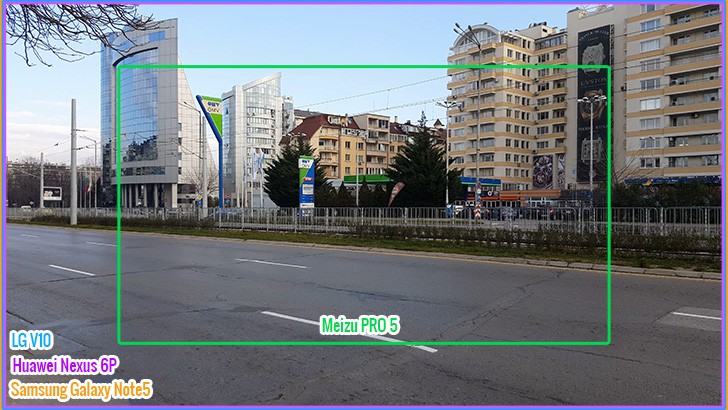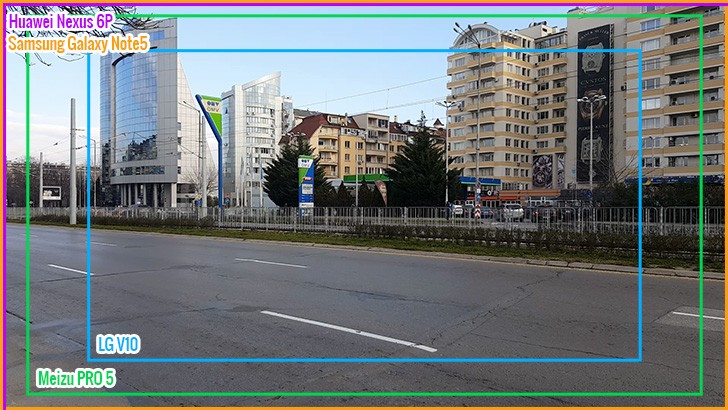Nexus 6P vs. LG V10 vs. Galaxy Note5: Jumbo joust
Jumbo joust

Video camera
All three cameras can do 2160p video, but we'll also examine their 1080p performance as not everyone gets the full benefit of the higher resolution (it takes up more space, is harder to share, not everyone has a 4K TV).
2160p video quality
It turns out our three main competitors have the same field of view when shooting 2160p video. It's only the Meizu PRO 5 that has a significantly narrower FoV.

Keep the FoV factor in mind, because it's easy to forget when inspecting a frame of the video up close. The Meizu PRO 5 can trick you into thinking it captures a superb level of detail (and it does to an extent), but comparatively, it's got an easier job than the others as it captures only so much of the scene.
The LG V10 produced the sharpest videos, that's clear to see in the signs (including the street sign in the distance). The Nexus 6P videos come second in sharpness, but also, the shadowy areas are quite underexposed.
The Samsung Galaxy Note5 has good dynamic range, though it loses a lot of detail to noise reduction. The Meizu PRO video looks pretty good if you manage to fit everything into the frame. Surprisingly, it was recorded at a modest 12Mbps - less bitrate than what the others use for 1080p.
But it uses the new HEVC/H.265 codec in action - it's way more efficient than H.264. The savings in storage come at the expense of compression artifacts, which are visible with a naked eye in the footage.
Regarding audio bitrate, the Galaxy Note5 uses the highest one - 256Kbps - while the LG V10 records audio at 156Kbps. Still, the LG with its advanced mic system managed to capture better sounding audio.
The Nexus 6P disappoints with a mono audio track - the quality of the sound is good, but the lack of stereo separation is audible. The Meizu PRO 5 shoots mono audio as well, and it sounds even worse.
Winner: LG V10. Wide FoV, sharp video and great audio clearly make the V10 the winner when it comes to high-quality video.
Runner-up: Huawei Nexus 6P. The quality of the video is quite high, but the audio recording feels outdated.
Third place: Samsung Galaxy Note5. Audio is very good, but the key component, video, leaves something to be desired.
1080p video quality
The Samsung Galaxy Note5 and Huawei Nexus 6P still offer wide FoV when switching to 1080p, but the LG V10 narrows its view significantly - it's even narrower than the Meizu PRO 5's.

The LG V10 gets a quality boost from the narrower FoV and the video is sharp and with good dynamic range. The Samsung Galaxy Note5 saves some face and with FoV accounted, it equals the V10.
The Huawei Nexus 6P videos appear soft and have issues both in the shadows and in the highlights. The Meizu PRO 5 once again records with a 12Mbps bitrate, but, at least, compression artifacts aren't visible.
Winner: Samsung Galaxy Note5. The LG lost some points due to its narrower FoV, while the Note5 did comparatively better than it did in the 2160p test.
Runner-up: LG V10. The quality is very high, but the benefits of the wide-angle camera lens are lost since it doesn't use the whole sensor.
Third place. The quality dropped and dynamic range issues persist, pushing the Nexus behind the competition.
Reader comments
- Anonymous
- 05 Aug 2018
- 7BD
I don't think it's tremendously fair to knock the V10's battery performance so much when you can actually get a full charge in under a minute... by swapping in another battery, something you absolutely can't do with the other two. That deserves point...
- coftedy
- 24 Dec 2016
- fuZ
LG V10 tc better than Google nexus #IG
- AnonD-551984
- 22 Jun 2016
- 4@R
Absolutely awesome review, appreciate the time spent here. Two things I'm bothered by, one even in final conclusion when speaking of battery you forget to point out the LG V10 will allow you to insert another battery with very little trouble. Th...